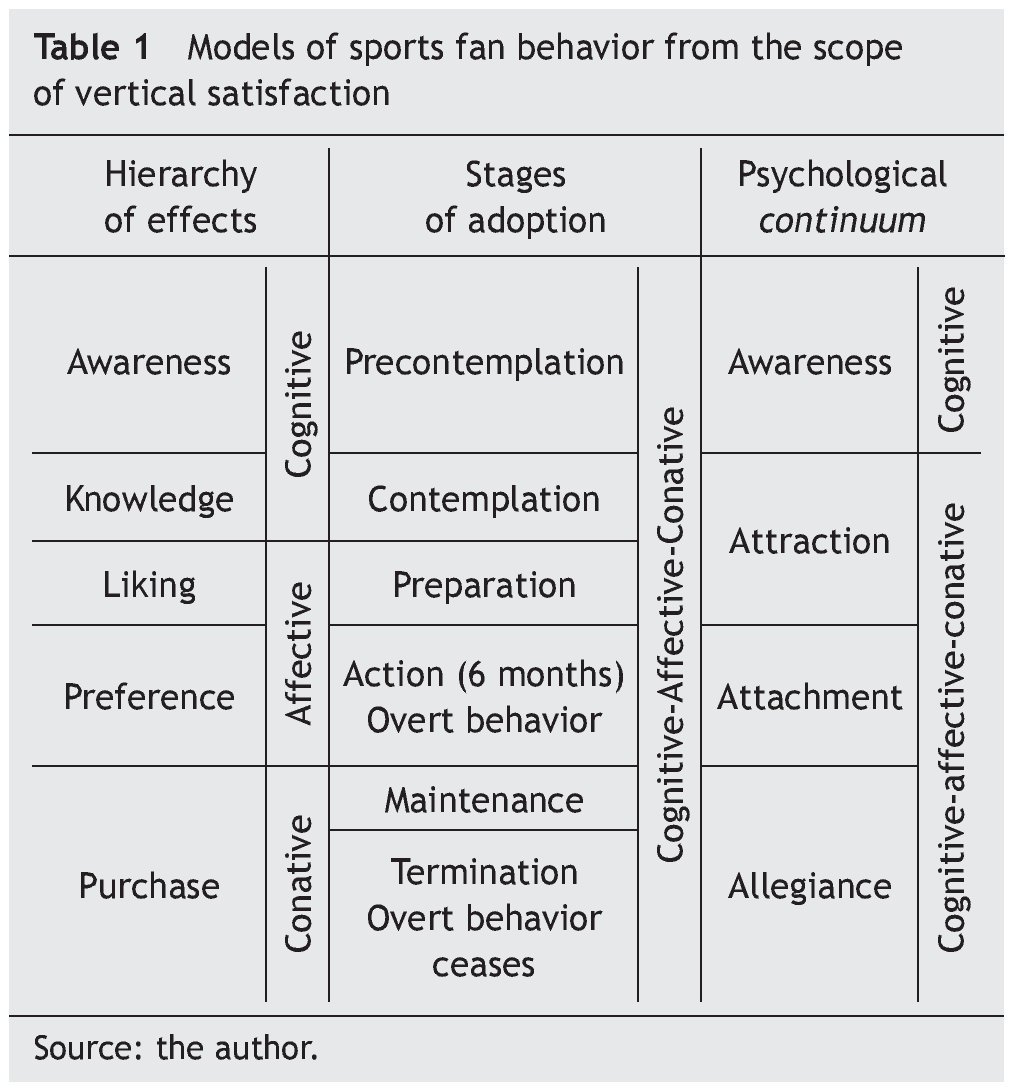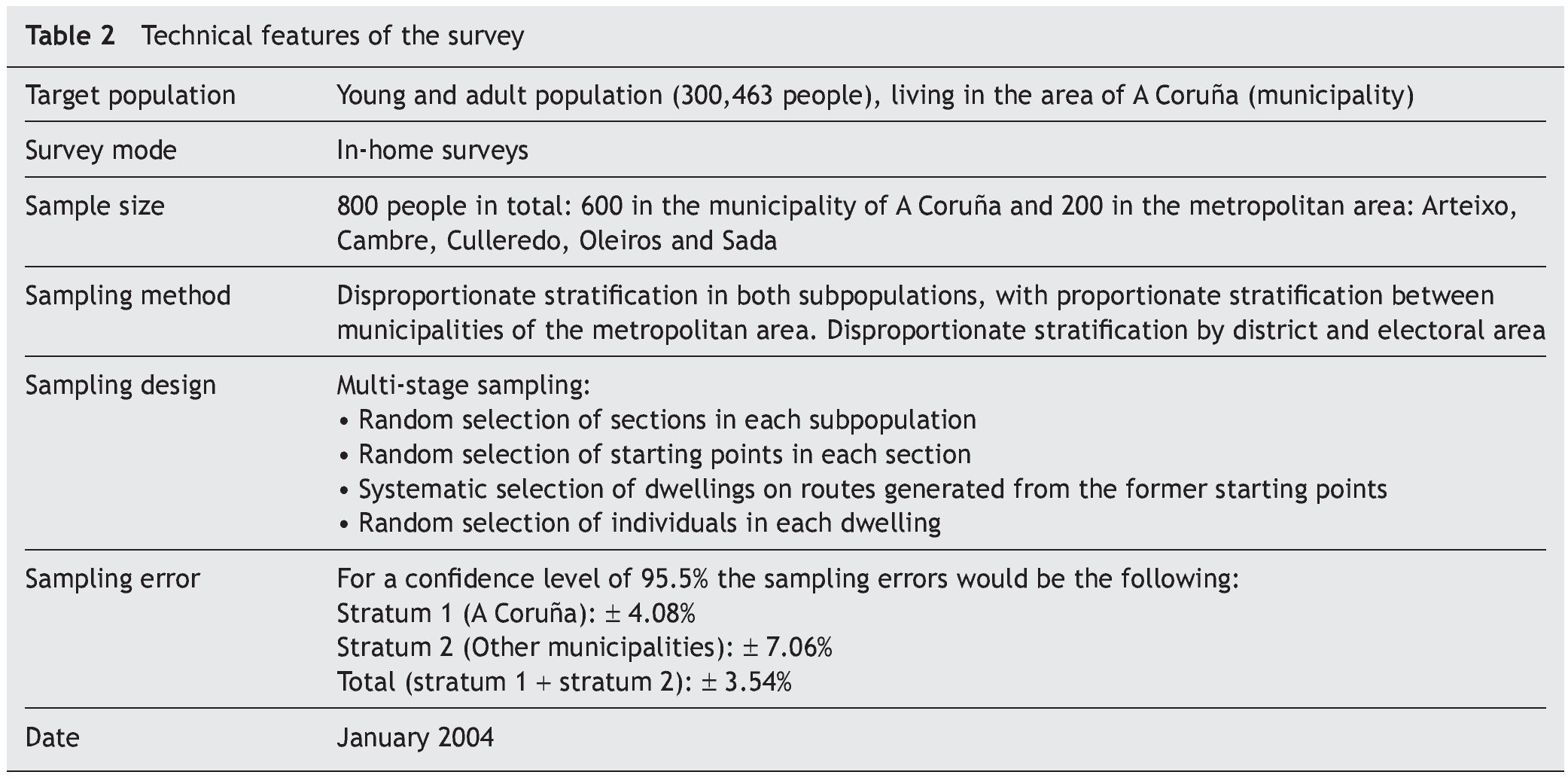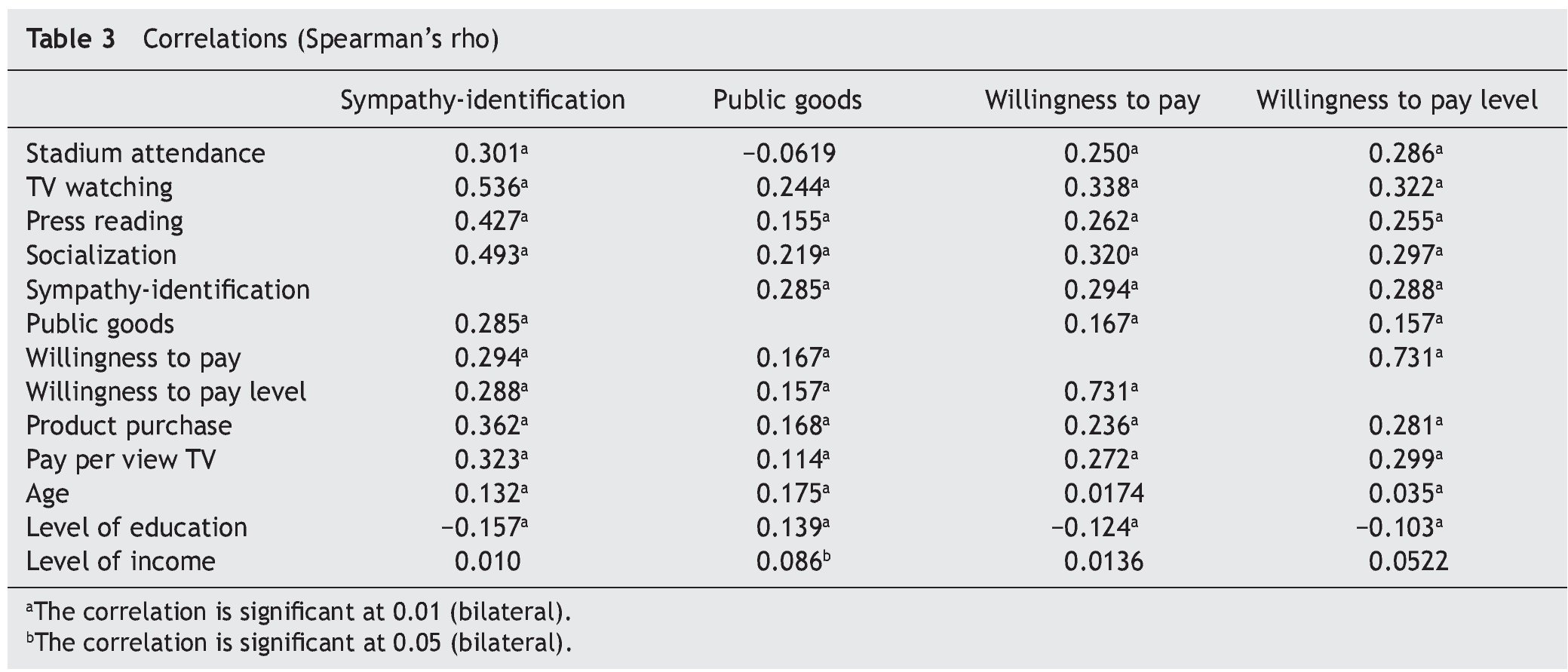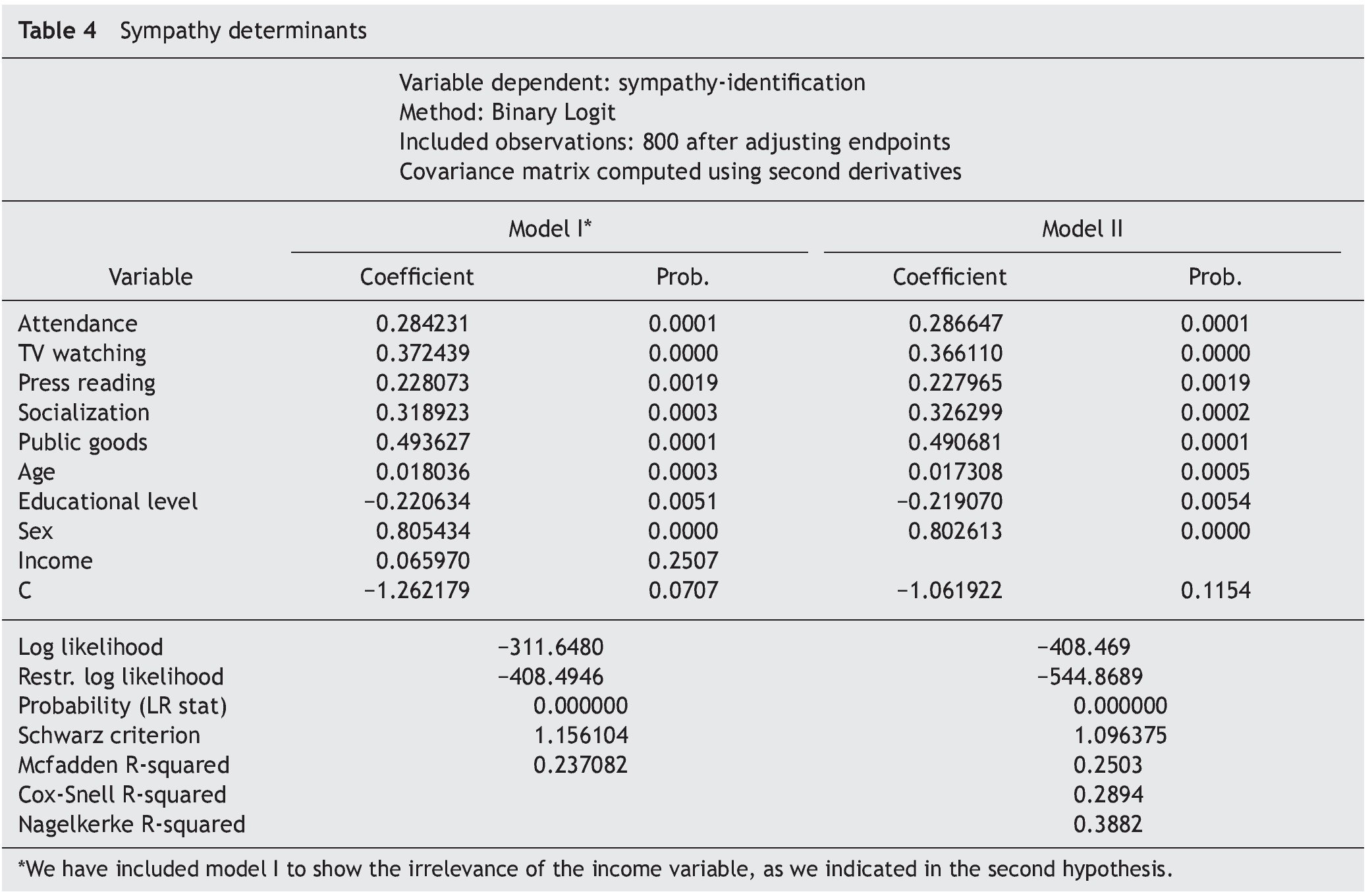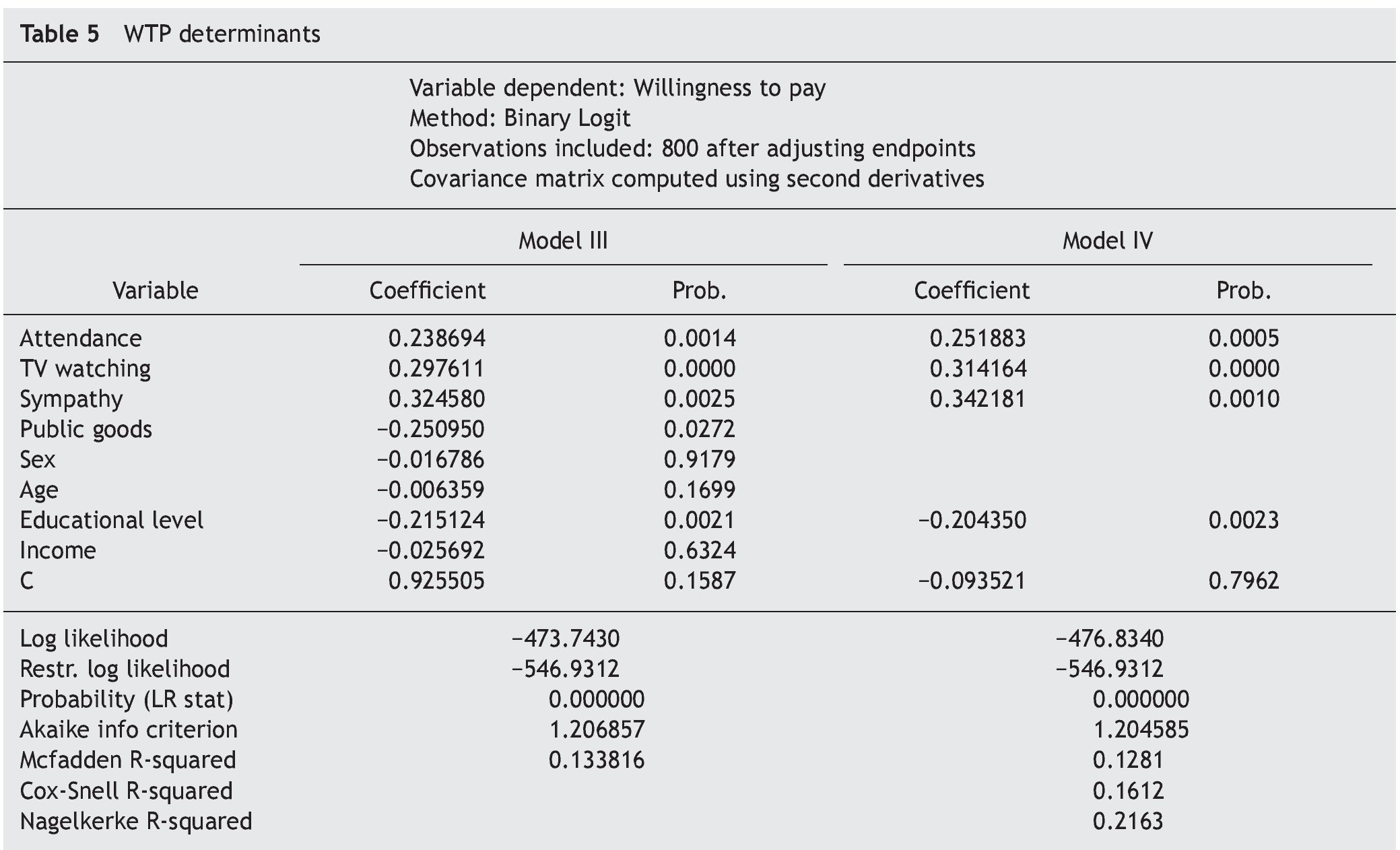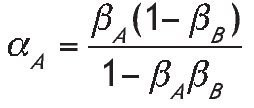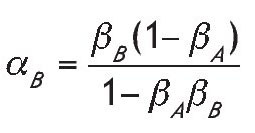The present study analyzes the effects of sympathy and identification between sports fans and clubs in the recognition of willingness to pay in favor of these organizations. With this objective, after reconsidering the diverse approaches to this type of bonds, we propose in the first part a theoretical model that considers the psychosociological factors which affect the willingness to pay for this kind of goods and services that have characteristics similar to public goods. This model allows us to extract two hypotheses on the interrelation between sympathy, income and willingness to pay. In the second part, we put these hypotheses to the test. The results establish, as predicted, that identification or sympathy with a club constitutes an important causal factor in its valuation, although income has no causal relation with this. Both can explain some irregularities found within the contingent valuation method.
El presente estudio analiza el impacto de la simpatía y la identificación entre seguidores y clubes deportivos sobre el reconocimiento de la disposición a pagar en favor de estas organizaciones. Para ello, después de reconsiderar los distintos acercamientos a este tipo de vínculos, en la primera parte proponemos un modelo teórico que considera los factores psicosociales que influyen en la disposición a pagar por este tipo de bienes y servicios, que tienen unas características similares a los bienes públicos. Este modelo nos permite elaborar dos hipótesis sobre la interrelación entre la empatía, los ingresos y la disposición a pagar. En la segunda parte ponemos a prueba estas hipótesis. Tal y como esperábamos, los resultados indican que la identificación o simpatía con un club constituye un importante factor causal en su valoración, mientras que esta relación no existe con la variable ingresos. Ambos factores sirven para explicar las anomalías encontradas en el método de valoración contingente.
1. Introduction
The analysis of consumption in sports is very complex if we compare it to any other expression of scenic art. This complexity is rooted in the anthropological basis of the sport (Elias and Dunning, 1986) and is especially evident in the psychological implications that individuals experience with relation to sporting events in general and the stable bonds or loyalty to clubs in particular. The characteristics of this bond imply that the approach must necessarily be multidisciplinary, since it presents economic, sociological and psychological facets, all of which are integrated under the general epigraph of consumer behavior (Beccarini and Ferrand, 2006).
The set of followers of a club constitutes a heterogeneous group that incorporates both those who simply follow the evolution of a team or occasionally watch sports and also those who unconditionally and directly support it. Thus we could even speak of diverse degrees of adherence and of a distinction between rational and 'apparently' irrational consumers. The rational consumer wishes to acquire some form of entertainment whereas the apparently 'irrational' one constitutes the hardcore of committed supporters. In this sense, the motivation or the causality of the consumption of a sporting event cannot be reduced to the results of a club. In this respect, the chain of victories is not the only indicator of the levels of interest, although it might have an effect on future levels of support (Branvold et al., 1997).
This leads us to the need to identify the typology of fans and explain the process of establishing a stable commitment to a certain team or sports group, as well as the effects derived from this type of bond.
At the same time, the studies of contingent valuation used in the assessment of public goods (like sports clubs1) and non-market goods in general have repeatedly demonstrated weaknesses that have resulted in the well¿known problems of the aggregation "embedding effect" and the purchase of moral satisfaction or "moral glow" (Kahneman and Knestch, 1992a, 1992b). This divergent evidence raises questions about the object of valuation and the determinants therein. The study of sympathy relations can constitute an explanatory alternative for determining the valuations of individuals not exclusively limited to the scope of sport (Sally, 1995; 2001 and 2002).
2. Behavioral explanatory models of identification and sympathy
The analysis of consumer behavior in this context requires the development of an explanatory model on the personal involvement of the subject, given the qualitatively and quantitatively diverse links that we find between consumer and club. By means of example, the mere spectator contemplates the evolution of the game without any personal involvement. On the contrary, for a supporter or fan, the evolution of one's team clearly affects one's level of well¿being, while implying a lengthy dedication of time and resources (Poole, 1978). These behaviors have already been the focus of an important number of studies that have highlighted the importance of the sociocultural environment, the factors of attraction (Branvold et al., 1997; Baade and Tiehan, 1990), as well as the cognitive and affective determinants (Madrigal, 1995) and the characterization of behaviors (Zillman and Paulus, 1993).
A good part of these studies on consumer satisfaction focus on the expectation¿confirmation model (Oliver, 1980). However, some investigations emphasize the role played by the emotional and affective dimensions (Madrigal, 1995).
Our perspective leads us to differentiate two kinds of satisfaction. While horizontal satisfaction is derived from the direct consumption of a product-event, vertical satisfaction is associated with involvement in the brand or club. The latter is classified within the scope of emotions (Beccarini and Ferrand, 2006) and can be interpreted using three possible models that explain the development of sympathy and relationships of commitment between fans and the club (Table 1).
The hierarchy of effects model focuses on the description of the phases that an individual follows in a purchase process (Barry, 1987). Methodologically, this type of model considers the learning process and its impact on the attitudes of the agents throughout the decision making process. Thus, an individual evolves from an initial awareness of a product's existence, knowledge, taste or appreciation of the product to preference and, finally, the purchase. Although the sequence of effects can hold a certain relation, the particularities of the consumption in sports imply that it is not totally possible to assimilate this kind of model when applied to habitual consumption. In the same way, this approach considers the existence of a dissociation of the cognitive, affective and conative dimensions that is not totally acceptable. In general, it means that individuals know, appreciate and then acquire, when these dimensions can be considered present in each phase of the sequence.
The model of the stages of adoption or the transtheoretical model, however, (Prochaska and Diclemente, 1982; Mullin et al, 2000), approaches the influential factors in behavioral changes from a multidimensional perspective. In this regard, the theory proposes the existence of six stages that go from a precontemplation to the total alteration of behaviors, all of them affected by contextual variables and open to new attitudes (supporting). As opposed to the previous theory, this one stresses the need for a degree of temporary persistence of behaviors, as well as the existence of an interrelation between cognitive, affective and conative dimensions, present in all the phases of the decision-making process.
However, both models lack an explanatory theory that goes beyond the simple description of the phases or stages. In this sense, the general model proposed by Funk and James (2001) attempts to justify the sociopsychological processes that lie behind the appearance of these different degrees of involvement, integrating the diverse attitudes of consumers into a continuum. This model establishes four borders in connection with the evaluative processes by means of which a person internalizes a social situation and that qualitatively mark the different stages regarding links with an object, such as a sports team, a brand name and so on.
As in the previous approaches, in the initial phase (awareness), the individual simply knows of the existence of the sport and its norms, but does not express any form of special attraction. Nevertheless, the phase of attraction implies that the subject has already decided on a specific object, largely motivated by sociopsychological and demographic factors (the context of membership, family, religious, racial and political reasons) with affective and conative dimensions. The third stage marks a qualitative leap, since in this phase (attachment), a psychological connection with the object and identification with its characteristics begin to crystallize. Finally, in the last stage (allegiance), the subject feels identified with the club and its symbols, thus affecting his/her behaviors in the long term.
Focusing on each one of the phases, an individual is initially 'conscious' of the existence of this scenic art. Given the omnipresence of sports activities, this initial point is usually associated with very early stages of life and through the familiar and social bonds in the socialization process. However, the emergence of new sports makes it possible for this stage to arise in adulthood. Geographical proximity, the influence of companions and bonds with the community can also be decisive in order to create a 'conscience', although this does not imply the existence of a particular interest for this type of activities. An increase in 'conscience' can turn into attraction insofar as the agent compares different sports and teams and makes a decision on his/her personal preferences. This election is the distinctive feature of this phase and is influenced by the psychological characteristics of the individual, social influences and hedonic reasons. In fact, not only can the paternal influences or the immediate environment be decisive, but the existence of a successful team and the opportunities of leisure are also relevant. This stage can be associated with direct spectators but also with fans through the mass media and is not necessarily stable; we are therefore speaking of a weak bond.
The involvement of an agent is characterized not only by revealing interest in the activity, but also by becoming known or being socially distinguished, giving a central dimension to his/her life style and undertaking the risks associated with the probable failure of the team. The meaning of the choice is then more internal than external, that is to say, the intrinsic meaning that the sports object has for the individual (Funk and Pastore, 2000). Obviously, when the object (team) generates answers that fortify the bonds with certain values and concrete beliefs and even favor the self-concept of the subject (citizen pride, social capital, affective links with a space or community...), this relation is strengthened. The attitude of the team is therefore essential (providing information, generating symbols, promoting certain values...).
Studies carried out within this stage show that the individuals found at this level follow the team as a form of escapism from their daily routine, so as to access a broader package of leisure services (Wann, 1995) and in particular, to achieve vicarious success (Mahony, 2000). The sporting events are finite and non¿predictable. The result cannot be anticipated from the beginning (at least to a great extent), making sport attendance a pleasurable experience, associated with a form of drama influenced by the knowledge and affection of the fan (Hirt et al., 1992). The distinctive characteristic that distinguishes fans from mere spectators is the formation of a tacit alliance with cognitive and affective effects where they perceive themselves as members of the same group, integrated due to the existence of a common identity and the pursuit of a specific objective (Zillman and Paulus, 1993).
These bonds can be causally explained by the BIRG strategies and their necessary corollary, CORF (Madrigal, 1995; Hirt et al., 1992). In the BIRG answer (Basking in Reflected Glory) the individuals maintain a strategy of exaltation of the self, that is, with the election of a specific object, subjects seek to raise their esteem in the eyes of others, increasing their association or connection with a highly successful group, brand or team.2 Thus, BIRG is an inclination (not only an affective movement) to share the glory of a figure which we could associate with due to diverse causes (origin, cultural identity...) or through a purely incidental form. CORF (Cutting off Reflected Failure), on the contrary, is a protection movement by means of which an individual wishes to be distanced from a source of problems or failures. This type of movements explains the attitudes of identification and non¿identification that are respectively related to "good and bad times".
Nevertheless, a bond with a team or group constitutes a dangerous strategy as dissociation after the election is more complex, since the follower sees the object as an extension of him/herself so that its success will be interpreted as personal success and its failures as losses. On the other hand, disagreement or the CORF answer requires an intentional cognitive process whereas the affective reactions are not found in conscious control mechanisms (Oliver, 1993; Westbrook, 1998). Consequently, the bonds established are clearly asymmetric.
Identification could be considered a final stage in this continuum and is a stable long¿term relation of fidelity with a certain group or cause. Studies on consumer loyalty present a long tradition in the scope of marketing (Pritchard et al., 1999) including their application to sports activities (Hansen and Gauthier, 1989). In general, these studies all suggest that loyalty is a more complex phenomenon than a mere measuring of attendance frequency, as it involves attitudinal aspects, not only the direct consumption of sporting events but also aspects that reinforce the personal connection, resist counter¿persuasion and influence cognitive processes with an impact on behavior (Mahony, 2000).
The line of thinking raised by the diverse explanatory theories allows us to establish a logical sequence of the stages or levels of support for a sports organization. However, all of them can be understood as phases within a continuum, a process in which the individual gradually increases the levels of sympathy¿identification with a certain club or organization. As we will see, the establishment of this type of bond will be understood in terms of commitment, income transfers, wealth and valuation, and can be interpreted as the existence of interdependence between utility functions.
2.1. Sympathy bonds and identification
The study of prosocial behaviors, that is to say, those behaviors that surpass the narrow frame of particular interest and move towards the construction of some form of community, insists on the importance of the sympathy concept to explain the existence of close relationships based on interactions such as families, clubs, communities, etc. (Sally, 1995). In this sense, Experimental and Behavioral Economics have demonstrated the relevance of aspects like sympathy, group membership (we¿rationality) and commitment in the explanation of the rationality of economic agents, especially in altruistic behaviors, valuations of public goods, etc. (Kahneman and Netsch, 1992; Milgrom, 1993).
This kind of relation is characterized by the fact that personal utility is affected by the perception of utility for others. We cannot therefore consistently speak of a function with a totally independent personal utility. Additionally, this interdependence is a decreasing function of distance, interpreted in a social sense. Finally, the existence of a sequence of interactions entails reciprocity, i.e., sympathy is not an unconditional answer (Sally, 1995; Sugden, 2003).
In this regard, we can understand that sympathy refers to two forms of identification. Sympathetic identification, whereby every individual is affected by other people's well¿being, given that empathetic identification is based on the mutual knowledge among members of some form of community (Pena and Sanchez, 2005).
The study of voluntary contributions to public goods, and in particular to the study of warm glow or the acquisition of some form of moral satisfaction, reveals that individuals obtain satisfaction from their prosocial action in favor of a specific group which they identify with, which would be ingrained in the psychological necessity of the construction of an identity or even in assertiveness itself (Andreoni, 1990). Following an altercentric point of view, as we see in behavioral models, the influence of socialization processes or inculturation is crucial. Individuals adopt prosocial behaviors in order to gain admiration or prestige among their equals. Symbolic interactionism, for example, considers that the underlying motivation is "empathic preferences". Individuals build up their personality based on the judgments of others in an authentic "self-looking glass" in such a way that the self would be no more than the "generalized other" (Mead, 1982).
Although there is no univocal interpretation of this concept within Economic Science, the diverse explanatory alternatives of prosocial behaviors interpret it as a kind of interdependent function of utility. This simplification, typical of methodological individualism, disregards the importance of social organizations, their ethics and their institutions in the economic coordination (Gui, 2000; Khalil, 2003), but allows us to formalize the capacity that this bond has in influencing individual decision¿making.
3. Sympathy and voluntary transfers
Following Becker (1976) and Stark (1995), a relation of sympathy can be modeled through a bine (a relation of interdependence between two subjects). In our case, for example, it can be made up of a club fan (A) and the club or a sports organization (B). We assume the existence of only one good x that is in the hands of A. This good can be interpreted as income in a Beckerian sense, e.g. money, time, human capital etc. The fan could invest his/her resources in supporting the club economically and socially.3 On the one hand, the consumption of x determines satisfaction or utility in a direct way (VA(x) > 0; VB(x) > 0), verifying that (V¢A(x) > 0; V¢B(x) > 0), and (V¢¢A(x) < 0; V¢¢B(x) < 0). On the other hand, each agent is individually influenced by the level of utility of the other in an indirect way. In other words, each agent directly wishes to have the goods and indirectly wishes for others to enjoy them too. Consequently, the utility of each agent would be represented within interdependent functions of utility:
where:
xA is the level of consumption made directly by A and destined to uses other than supporting the club
xB is the level of consumption made by B derived from fans' contributions
β is a parameter reflecting the concept of sympathy
Indeed, β is the weight that the utility of the other individual plays in one's own utility (-1<β < 1). A positive value of β reflects altruistic behavior, a negative value shows positional egoistic behavior, and a value of 0 corresponds to a situation of indifference, no¿tuism. In terms of the behavioral models considered in the previous section, a positive value of β represents the existence of BIRG type bonds (basking in reflected glory). A null or negative value considers both the existence of CORF (cutting off reflected failure) and the desire to contribute to the failure of a certain club.
Rearranging equations (1) and (2), the utility function of each agent can be expressed as follows4:
where the parameters
and
show the weight of the utility derived from the consumption made by the other agent.5
For the sake of analytical simplicity and in order to determine the optimal level of consumption of both agents, the following functional specifications can be assumed:
In this case, the optimal level of consumption for A would be
The first order condition of maximization of utility from the perspective of A is
The same condition for B is
hence
Thus, club fan (A) who maintains a relationship of sympathy, will consume a higher level of x than the club (B) would wish from its perspective. This result could also be derived directly from the condition αA +αB < 1. In general, if we consider A and B jointly, the level of consumption desired by both with respect to the other is always smaller than the level they really wish to maintain from an individual perspective.
Nevertheless, the existence of sympathy relations entails a reduction in the margins of conflict derived from these divergences in preferences with respect to the others, and contributes to an approach of preferences or a reduction in the natural margins of conflict in a negotiation, to the point at which these would disappear in the case that αA +αB = 1 is verified (Figure).
Figure. Line of margins of conflict and sympathy. Source: the author, based on Stark (1995).
According to the previous analysis it can be concluded that a bond of mutual sympathy implies the existence of tacit negotiation and conflict¿free transfers between individuals. In other words, the extension of relations of sympathy implies the appearance of a willingness to pay or to make voluntary contributions. This means that fans or supporters choose to voluntarily give a part of their consumer surplus up. This result could also be interpreted as a reduction in the transaction costs.
This leads to the so-called shrinking theorem: the existence of interdependent utility functions involves the appearance of either tacit transfers or a greater willingness to pay. Agents who show a bond of sympathy with a community, club or cause would therefore be willing to let part of their consumer surplus go. This result could be considered counterintuitive from the point of view of rational choice, something with clear implications for the interpretation of the contingent valuation models. Also, under this perspective, the free-rider problem in contributions to public goods would be overcome, because the fan perceives a kind of moral glow satisfaction directly linked with the sympathy relation.
The most interesting implication of the model previously developed has to do with the effects of the variation in sympathy levels. As we have seen, the intensity of sympathy is gathered in the initial parameter β that is the weighting that subject A or B assigns to the utility for the other individual regarding their own utility.
An increase in the level of sympathy in A will cause a reduction of the consumption desired by A and an increase of the consumption desired by B from A. In terms of Figure, it involves a displacement of subject B on the straight line of the ratio, and consequently, a reduction in the conflict area.
By contrast, an increase in income levels would not lead to a narrowing of the conflict margins, since it does not mean an alteration in the relative positions of the two agents. Thus, an increase of the endowment of x does not modify the optimal positions. We can therefore deduce that, paradoxically, the potential conflicts of redistribution are not a decreasing function of the income levels but are only a decreasing function of the levels of sympathy, and in such a case, of the relation between sympathy and income levels.
In order to verify that the optimization process depends exclusively on the sympathy levels and that the value of ratios calculated in (5) and (6) would not be affected, it would be necessary to simply introduce a modification in the initial constraints in the previous model: xA + xB = kx ;k > 1.
In short, only modifications in the sympathy levels can ensure increases in the levels of transfers or willingness to pay.
One of the main implications of this result is that this perspective allows us to integrate the two main dissonant experiences observed in the empirical studies within the analysis of the influential factors in the contingent valuations (Kahneman, 1992a).
On the one hand, the problem of the embedding effect makes reference to the arbitrariness observed in the studies on the valuation of public goods that call into question possibilities of aggregation, in spite of being consistent values. In these studies, the willingness to pay did not undergo significant variations if we considered specific goods (a forest) as an object or a wider set of goods which this can be integrated into (the environment). The reason for this apparent dissonance lies in the object of the relation of sympathy itself. The relation that binds an individual with a club is the same one that ties him/ her with sports in general, in the same way that it is difficult to split the relationship between a specific natural asset which one can relate to and the environment in general.
On the other hand, these studies showed a possible relationship between the willingness to pay and the desire to acquire some form of moral satisfaction (warm glow living) through voluntary contributions. Whereas the acquisition of moral satisfaction explains embedding, sympathy offers a wider explanatory framework in order to interpret the socio-personal determinants of the valuations.
4. Empirical evidence
In the previous section we outlined some verifiable hypotheses related to the influence of sympathy on the variability of Willingness to Pay for goods or services provided by an agent who the subject has a particular affinity with. Our empirical analysis puts both hypotheses to the test:
(i) First, the existence of a direct relationship between the sympathy relations and the willingness to pay or to contribute to the support of a certain sports club. Moreover, those club fans showing greater levels of sympathy should tend to express higher levels of willingness to pay than those who describe themselves as mere followers.
This hypothesis is not a truism. This kind of contribution is analogous to donations to public goods, the agent is in a typical free¿rider problem and therefore he/she would not express willingness to pay.
(ii) Secondly, there is no link between the willingness to pay and income, although the former is mainly determined by sympathy. This second statement is counterintuitive if we consider the standard theory of consumption. The consumption in sporting events is normal, that is, the consumption is expected to increase when income increases (Siegfried and Peterson, 2000), but the existence of sympathy relations can alter this link through WTP.
Our explanatory model identifies the main determinants for the emergence of sympathy¿identification relations and willingness to pay.
The empirical analysis is based upon data taken from a survey conducted in 2004 on the population of the metropolitan area of A Coruña (Spain) with respect to the following level and the local soccer club (Deportivo de La Coruña). The questionnaire used consisted of thirty¿two questions based on habits, consumption in sporting events, sympathy and willingness to pay, and was incorporated into the socio-demographic characterization of the population (Table 2).7
The people interviewed were asked to value the relation between the history of the club and their personal well¿being. That is to say, we assessed the interrelation of the utility functions or the sympathy relations between the club and individuals. The answers allowed us to establish an ordinate classification of the levels of interdependence between them: from indifference and rejection to the recognition of a high degree of dependency. For the construction of an explanatory model, these positions were simplified in two great blocks that show the existence or not of interdependence relationships. At the same time, we studied the willingness to pay by asking contingent valuation questions.
The survey results reveal the existence of a large percentage of the population, much higher than the percentage that claims to follow the club directly, who show a significant level of sympathy (they adhere to the affirmation that the club's sporting achievements affect their personal well¿being). More specifically, it caters for a volume nearing 43% of the total of the population. On the contrary, those that we could define as indifferent do not exceed 24%.
The correlation analysis shows the strength and direction of the relationship between sympathy and other variables. The results are reported in Table 3 and they suggest the existence of a clear relationship between sympathy and any of the forms of following (attendance, television viewing, reading of the press and socialization8). Likewise, the results of this kind of analysis also suggest a clear link between sympathy and any of the variables that reveal willingness to pay9 (the consideration of the team as a public asset, willingness to pay and the consequent product purchase) as predicted in our first hypothesis. On the other hand, the income variable is neither related to the willingness to pay nor with sympathy, as we affirmed in the second hypothesis. On the other hand, while age positively affects the sympathy level, the level of education affects it negatively.10
In order to build an explanatory model of the presence of sympathy attitudes, the behavioral models analyzed in the second part of this paper stress the importance of two groups of variables: Variables that characterize the level of consumption of this kind of service and socialization variables related to the construction of personal identity.
Given the characteristics of the dependent variable (dichotomous) we have employed a Binomial logistic regression.11 The estimation allows us to emphasize the explanatory capacity of following indicators (e.g. television viewing, reading the press...), as well as the key factor of group socialization, on the existence of bonds of sympathy (Table 4, Model II). At this point, some comments are worth noting. Age is also a significant explanatory factor for a greater level of sympathy. In this sense, as a form of Social Capital, the generation of this kind of bonds can be understood as a process of capitalization. In contrast, the level of education represents an obstacle for the appearance of this bond with sports clubs. In the same way and derived from socio¿cultural patterns of behavior, sex is a variable with an important explanatory weight.
In order to test the link between willingness to pay and sympathy, another binary logistic explanatory model has been estimated. Table 5 (model IV) provides some evidence of the strength of this relationship. In general, it is clear that those individuals showing high levels of sympathy also declare a higher willingness to pay. In fact, this type of relationship would significantly foster the appearance of negotiation¿free transfers, as we deduced from the model in our first hypothesis. This result could be explained by the excess of consumer surplus - derived from a direct consumption (attendance) or indirect (TV watching), but heavily conditioned by the existence of relationships of sympathy¿identification and socio-cultural factors (educational level...).
In this second model, income was yet again excluded because it lacks significance (Model III). Thus, once again this variable does not constitute a determining factor for the existence of transfers or their amount, as we concluded in our second hypothesis.
5. Conclusions
The explanatory models of sports loyalty by consumers to certain clubs from a psychosociological perspective reveal the appearance of interdependence bonds (such as BIRG) between the subject and the club of reference, which can be interpreted as the generation of sympathy links.
In this regard, the analysis and modeling of these relationships (the interdependence of utility functions) allow us to explain sports consumer behaviors, apparently irrational, by means of the derivation of effects generated by this type of bond in the patterns of consumption and donation.
From a model of sympathy in bines, two basic hypotheses are derived. On the one hand, the existence of a direct relationship between this type of bond and transfers without conflict, which would be understood in terms of willingness to pay. On the other hand, this disposition bears no relation with levels of income. Both affirmations have been verified empirically.
Although the study focuses on the scope of the contingent valuation of sports clubs, we found evidence that covers the valuation of public goods and non-market goods in general, and have an explanatory capacity for both problems found in the analyses of contingent valuation: embedding and the purchase of moral satisfaction as a motivation of willingness to pay.
Acknowledgement
The authors acknowledge financial support by 10SEC100041 PR from the Xunta de Galicia.
Received April 7, 2011; accepted March 13, 2012
*Corresponding author.
E¿mail address:santos67@udc.es (J.M. Sánchez Santos).
1. Sports teams can be considered as capable of generating public goods because some of them are indivisible entities and present non¿rivalry (civic pride, publicity, income through the export of services... Among the works that analyze this characteristic we could highlight Johnson and Sack, 1996; Johnson et al., 2001; Johnson and Whitehead, 2000.
2. The identification with a team is related to self¿esteem and an optimistic perspective on life and negatively with negative affective experiences (Branscombe and Wann, 1991).
3. It is important to note that a supporter not only makes economic contributions, but time and even knowledge, experience, etc. could be crucial in the generation of the great sporting events.
4. The introduction of interdependence by the club UB(xA,xB) = (1 - αB)VB(xB) + αBVA(xA) can be interpreted as such because the club is not indifferent to the situation of its supporters, that is, the organization cannot be understood without its nucleus of followers.
5. Logically, the condition αA + αB < 1 should be fulfilled, since in cases where the condition were higher than 1 it would simply be necessary to consider a change in the agents (A would become B and vice versa) and would respond to situations of mutual extreme altruism or proexistence in which each one of them lives more on the terms of the other than on their own. The results in a situation of this type are equivalent to an interchange of personalities, in such a way that decisions are adopted according to the criteria of the other rather than by oneself, and decisions in both are based more on the criteria of the other than on one's own.
6. f represents the logical inferior value of the bond between the club and subject A.
7. The questionnaire is available upon request.
8. To acknowledge the club as a means for developing networks of social relations.
9. In the survey we study the existence of willingness to pay and the amount with which the individual is willing to contribute (willingness to pay level) in two different variables.
10. It is logical if we consider that sympathy relationships can be similar to a form of social capital, and at the same time, there is a degree of stratification regarding leisure activities and education levels.
11. Logistic regression predicts a discrete outcome, such as group membership from a set of variables that may be continuous, discrete, dichotomous, or a combination of any of these, as the case may be.
References
Andreoni, J., 1990. Impure altruism and donations to public goods; a theory of warm glow giving. Economic Journal 100, 464¿477.
Baade, R.A., Tiehan, L.J., 1990. An analysis of major league baseball attendance 1969-1987. Journal of Sport and Social Issues 14, 14¿32.
Barry, T., 1987. The development of the hierarchy of effects: a historical perspective. Current Issues and Research in Advertising 9(2), 251¿295.
Beccarini, C., Ferrand, A., 2006. Factors affecting soccer club season ticket holders' satisfaction: The influence of club image and fans' motives. European Sport Management Quarterly 6(1) 1-22.
Becker, G., 1976. The economic approach to human behavior. University of Chicago Press, Chicago.
Branscombe, N.R., Wann, D.L., 1991. The positive social and self concept consequences of sport team identification. Journal of Sport and Social Issues 15, 115¿127.
Branvold, S. E., Pan, D.W., Gabert, T.E., 1997. Effects of winning percentage and market size on attendance in minor league baseball. Sport Marketing Quarterly 6(4), 35¿42.
Elias, N., Dunning, E., 1986. The quest for excitement. Blackwell, Oxford.
Funk, D.C., James, J., 2001. The psychological continuum model: a conceptual framework for understanding an individual's psychological connection to sport. Sport Management Review 4, 119¿150.
Funk, D.C., Pastore, D.L., 2000. Equating attitudes to allegiance: the usefulness of selected attitudinal information in segmenting loyalty to professional sports teams. Sport Marketing Quarterly 7, 51¿67.
Gui, B., 2000. Beyond the transactions: on the interpersonal dimension of economic reality. Annals of Public and Cooperative Economics 71, 139-169.
Hansen, H., Gauthier, R., 1989. Factors affecting attendance at professional sports events. Journal of Sport Management 3, 15¿32.
Hirt, E. R., Zillmann, D., Erickson, G., Kennedy, C., 1992. Cost and benefits of allegiance: changes in fans' self¿ascribed competencies after team victory versus defeat. Journal of Personality and Social Psychology 63, 724-738.
Johnson, A.T., Sack, A., 1996. Assessing the value of sport facilities: the importance of non economic factors. Economic Development Quarterly 10, 369-381.
Johnson, B.K., Groothuis, P.A., Whitehead, J.C., 2001. The value of public goods generated by a major league sports team: The CVM approach. Journal of Sport Economics 2, 6-21.
Johnson, B.K., Whitehead, J.C., 2000. Value of public goods from sports stadiums: the CVM approach. Contemporary Economic Policy 18, 48¿58.
Kahneman, D., Knetsch, J., 1992a. Valuing public goods: the purchase of moral satisfaction. Journal of Environmental Economics and Management 22(1), 57¿71.
Kahneman, D., Knetsch, J., 1992b. Contingent Valuation and the value of public goods: reply. Journal of Environmental Economics and Management 22(1), 91-93.
Khalil, E.L., 2004. What is altruism? Journal of Economic Psychology 25(1), 97¿123, 141¿143.
Madrigal, R., 1995. Cognitive and affective determinants of fan satisfaction with sporting event attendance. Journal of Leisure Research 27, 205¿207.
Mahony, D.F., Madrigal, R., Howard, D.R., 2000. Using the psychological commitment to team scale to segment sport consumers based on royalty. Sport Marketing Quarterly 9(1), 15¿25.
Mead, G.H., 1982. The individual and the social self. Chicago University Press, Chicago.
Milgrom, P., 1993. Is sympathy an economic value? Philosophy, economics and the Contingent Valuation Method a critical assessment. In: Hausman, J.A. (Ed.), Contingent evaluation: A critical assessment. Elsevier, New York: North Holland, pp. 417¿441.
Mullin, B., Hardy, S., Sutton, W.A., 2000. Sport marketing. Human kinetics Publishers, Champaign, IL.
Oliver, R., 1980. A cognitive model of the antecedents and consequences of satisfaction decisions. Journal of Marketing Research 17, 460-469.
Oliver, R., 1993. Cognitive, affective and attribute bases of satisfaction response. Journal of Consumer Research 20, 418-430.
Pena López, J.A., Sánchez Santos, J.M., 2006. Altruismo, simpatía y comportamientos prosociales en el análisis económico. Principios: Estudios de Economía Política 4, 55¿70.
Pooley, J.C., 1978. The sport fan: a social psychology of misbehavior. Sociology of Sport Monograph Series. University of Calgary, Calgary.
Pritchard, M.P., Havitz, D., Howard, D.R., 1999. Analyzing the commitment¿loyalty link in service contexts. Academy of Marketing Science 27, 333-348.
Prochaska, J.O., Diclemente, C., 1982. Transtheorical therapy toward a more integrative model of change. Psychotherapy: Theory, Research and Practice 19, 276-287.
Sally, D., 1995. Conversation and cooperation in social dilemmas: a meta¿analysis of experiments from 1958 to 1992. Rationality and Society 7 July, 58¿92.
Sally, D., 2001. On sympathy and games. Journal of Economic Behavior and Organization 44, 5¿6.
Sally, D., 2002. Two economic applications of sympathy. The Journal of Law, Economics and Organization 18(2), 455¿487.
Siegfried, J., Peterson, T., 2000. Who is sitting in the stands? The income level of sport fans. In: Kern, W. (Ed.), The economics of sports. Upjohn Institute for Employment Research, Kalamazoo, MI.
Stark, O., 1995. Altruism and beyond; an economic analysis of transfers and exchanges within families and groups. Cambridge University Press, Cambridge.
Sugden, R., 2003. The logic of team reasoning. Philosophical Explorations 6, 165¿181.
Wann, D.L., 1995. Preliminary motivation of the sport fan motivation scale. Journal of Sport and Social issues 19, 377-396.
Westbrook, R., 1987. Product/consumption-based affective responses and postpurchase processes. Journal of Marketing Research 24, 258¿270.
Zillmann, D., Paulus, P., 1993. Spectators: reactions to sports events and effects on athletic performance. In: Singer, M., Tennant, L. (Eds.), Handbook of research on sports psychology. MacMillan, New York.




